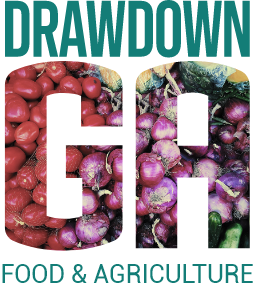Head over to the Carbon Reduction Visualizer to explore data on Georgia’s greenhouse gas emissions. You can see how emissions fall if we scale solutions to ambitious, but achievable, levels.
Food & Agriculture

Here’s the deal
The way we grow our food, what we eat, and what happens to excess and waste are all essential parts of our carbon footprint. To cut carbon substantially, we need to grow food in ways that benefit the land, sequester carbon, foster plant-forward diets, reduce food waste, and increase composting.

Composting
Comp...
When food waste and other organic materials decompose in landfills, methane, a potent greenhouse gas, is released. When we compost these materials instead, the organic matter is broken down by microbes into nutrient-rich, carbon-sequestering fertilizer.
Climate Smart
Agriculture
Clim...
Conservation agriculture relies on practices like crop rotation, cover cropping, and reduced tillage to benefit the land and sequester carbon in the plants and soil.
Plant-Based
Diet
Plan...
A diet rich in plant-based foods reduces emissions associated with meat production. This solution assumes people maintain a 2,500 calorie per day nutritional regimen; meet daily protein requirements; and purchase locally produced food when available.
Reduced Food
Waste
Redu...
Food waste happens all along the journey from the farm to your plate, and continues when we purchase more food than we consume. It is estimated that over 2 million tons of food is wasted in Georgia every year.
Composting
When food waste and other organic materials decompose in landfills, methane, a potent greenhouse gas, is released. When we compost these materials instead, the organic matter is broken down by microbes into nutrient-rich, carbon-sequestering fertilizer.
Conservation Agriculture
Conservation agriculture relies on practices like crop rotation, cover cropping, and reduced tillage to benefit the land and sequester carbon in the plants and soil.
Plant-Forward Diet
A diet rich in plant-based foods reduces emissions associated with meat production. This solution assumes people maintain a 2,500 calorie per day nutritional regimen; meet daily protein requirements; and purchase locally produced food when available.
Reduced Food Waste
Food waste happens all along the journey from the farm to your plate, and continues when we purchase more food than we consume. It is estimated that over 2 million tons of food is wasted in Georgia every year.
Here’s where we are
According to Georgia’s Environmental Protection Division, about 800,000 tons of food residuals are sent to Georgia’s landfills each year. About 48% of the food residuals come from the greater Atlanta area. Reducing the food waste that ends up in Georgia’s landfills, through composting and other means, is an important part of Georgia’s carbon reduction opportunity.

Here’s where we are
Frequently Asked Questions
What happens to food waste in Georgia?
Each year, 12 percent of the garbage produced in the state consists of food scraps and other wasted food, weighing in at over 800,000 tons. Nearly half of this food waste comes out of the greater Atlanta area.



